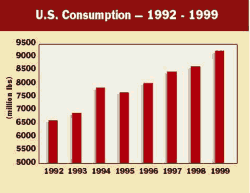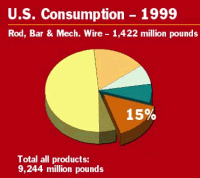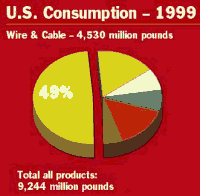February 22, 2001
FOR IMMEDIATE RELEASE
By Andrew G. "Andy" Kireta, Sr., President and CEO, Copper Development Association
Reproduced with permission from American Metal Market © 2001 Cahners Business Information. All rights reserved.
The applications for copper have gone through countless changes for 10 millennia, and the new millennium is no different. The more we use copper, the more we find out about the wondrous things it can do and what it can do for us.

For the 2000s, the outlook continues to be bright. From copper's nutritional value in our daily diets to its enduring beauty, from its superior electrical and thermal conductance properties to the multitude of features offered by more than 400 major alloys--copper is, indeed, the metal for the new millennium.
State-of-the-art applications in high-speed, high-capacity semiconductors are among the most notable recent applications, but other exciting developments are on the horizon ranging from electrical energy efficiency to the containment of harmful bacteria. This is truly an exciting time to be in the copper industry.

Overview
My predecessor, Bob Payne, who retired in December after 10 years at the helm of the Copper Development Association (CDA), helped guide the market development of this industry to new heights. Let's take a look at some of the most recent numbers.
The U.S. copper industry is headed for its fifth straight record year. Total consumption levels for the first 11 months of 2000 are 2.9 percent ahead of 1999. The United States represents nearly 5 percent of the world's total population; however, it consumes some 20 percent of the world's refined copper output. This amounts to almost 34 pounds per capita, one of the highest levels in the world.
Total 1999 U.S. end-use consumption (copper and copper alloy mill and foundry products to domestic markets), at 9.2 billion pounds, set an all-time record, up 5.3 percent from the 1998 level of 8.8 billion pounds. Copper consumption in the United States grew almost 40 percent for the period 1992 to 1999. That's a compound annual growth rate of 4.5 percent, outstripping the growth of the U.S. Gross Domestic Product (GDP), which was 3.3 percent for the same period.

Demand
There's increasing demand for copper tube, brass rod, and electrical and telecommunications wiring stemming from robust activity in the housing, commercial construction, air-conditioning and transportation markets.
Copper has an 81 percent market share for water tube nationwide, while virtually all branch wiring in new homes and commercial buildings is solid copper. The growth of the Internet and the consumer and commercial demands for being "connected" is pushing up high-capacity (Category 5 or better) copper wiring installations. Meanwhile, the increased production of automotive vehicles and their increasing reliance on electronics are fueling a surge in copper for wiring harnesses and related devices.

The demand for copper magnet wire (more than 800 million pounds in 1999), used for winding motors and transformers, continues to grow, based in large part on the need for improved electrical energy efficiency in order to achieve America's conservation goals.
Exports to Third World countries, along with innovations in automotive radiators, business electronics, electrical motors and plastic mold tools, among others, are expected to spark greater demands for man's oldest metal as we move forward in the decade.
Recycling counts, too. Not only is the United States the world's largest consumer of copper, it is also the world's largest collector of copper scrap. The United States has the world's largest resource base of copper products in use, estimated to exceed 81 million tons of copper. Copper continues to be one of the most highly recycled metals; copper from secondary sources currently accounts for 45 percent of all U.S. consumption.

Rod and Bar
At 1.24 billion pounds, rod and bar achieved a record year in 1999, accounted for more than 13 percent of all consumption of copper and copper alloy mill and foundry products, and appears on its way to another record in 2000. Free-cutting brass applications are the dominant influence. Plumbing products, at 474 million pounds, continue as the largest market in this sector followed by the power utilities and industrial valve markets at more than 200 million pounds each.
Mechanical wire, at 115 million pounds, has grown almost 20 percent since 1994, due primarily to increased consumption by fasteners and closures.
Wire and Cable
As always, this is the number one product area with 4.5 billion pounds in 1999, 49 percent of all copper and copper alloy mill and foundry products. It appears headed for a fifth straight record year, when the numbers are tallied for 2000. Building wire is the largest end-use market, accounting for more than 1.4 billion pounds, and telecommunications holds down second place at 657 million pounds. Together, these two markets account for 45 percent of all wire and cable consumed in the United States in 1999.
Electrical energy efficiency continues to be an important driver in the wire and cable markets. Following CDA's lead, other independent groups--National Electrical Manufacturers Association (Nema) and Consortium for Energy Efficiency (CEE) have raised the bar on efficiency standards for motors, encouraging purchasers to go beyond the requirements of the Energy Policy Act. This means more copper in motor windings.
Meanwhile, similar efficiency concerns are spurring enhanced windings in transformers and the upsizing of building wire in commercial and industrial buildings. Power quality concerns are also a stimulus to upsize the wiring as well as motivation to upgrade grounding provisions. All this translates to increased consumption.
On the residential construction side, efforts are under way to have the National Electrical Code increase its 14 AWG minimum size to 12 AWG. Such change won't come easily or quickly, but it would result in 60 percent more copper per foot of home wiring. Such a change would enhance the safety and functionality of home electrical distribution, where power demands have risen nearly 900 percent between the 1950s and 1990s.
Telecom wiring got a boost from the Federal Communication Commission (FCC) this past July from a new ruling that requires the use of Category 3 wiring minimum for all new installations. Whereas plain old telephone service (POTS) wiring comprises two twisted pairs of 24 AWG, Cat 3 (also Cat 5 or better) comprises four pairs. Add to this the current and growing interest level in handling Internet, entertainment and other advanced communications capability to every room of the home, and you've got a powerful market demand that eventually can add up to 20 extra pounds of copper wire in each new home. That can mean as much as 20 million annual pounds of copper in the not-too-distant future that doesn't exist today.
Transportation
The latest CDA study shows some 55 pounds of copper in an average vehicle, and this should continue to increase due to the product mix of vehicles being assembled. Light trucks, especially sports utility vehicles (SUVs), constitute most of the production. Such vehicles contain more electrical and electronic components and consequently more wire. And, as Detroit moves toward the production of hybrid electric vehicles, it will be a boon for copper. Not only will they call for more copper wiring, but new nickel metal hydride batteries with their innovative applications of copper could add more than 90 pounds of copper per vehicle.
Sheet, Strip and Plate
These products make up about 16 percent, some 1.5 billion pounds, of all copper-containing products consumed in the United States in 1999. That represents a 13 percent move upward from the previous year and a general upward trend averaging 5.2 percent annually since 1992. The increase is due largely to coinage production by the U.S. Mint and an accelerated demand for electronics and building construction. Coinage, alone, grew an impressive 86 percent in one year, making it the second largest market in this product category, attributable mainly to the new state quarters and the new dollar coins. Architectural product numbers, up 12 percent from 1999, continue at near record levels.
Castings and Powder
This product area held its own in 1999, at about 440 million pounds. The EnviroBrasses, a family of essentially lead-free casting alloys introduced over the past couple of years, accommodate federal environmental and health concerns and are finding a welcomed reception in the plumbing products market.
Studies continue and conversions mount on the great benefit that copper alloys have for casting mold tools. Their heat transfer and hardness properties, especially when chromium coated, offer distinct advantages to manufacturers seeking greater quality control, reduced cycle time and improved resistance to mold wear.
On another front, research and prototype development continues full steam ahead on the production of a copper motor rotor. Such a product bodes well for significantly increasing the use of copper in electrical motors and can offer the world a dramatic increase in motor efficiency, reducing fossil fuels used for electrical generation and their attendant adverse effect on the environment. Potentially exciting news here later in the year.
Tube, Pipe and Fittings
Some 1.4 billion pounds of copper went into tube, pipe and fittings in 1999, 15 percent of total consumption. Plumbing tube, alone, represents 734 million pounds. Despite challenges from plastic alternatives, it's been growing at a compound annual rate of 6 percent per year since 1992. Commercial tube, at 662 million pounds, has grown at the rate of 4.2 percent over the same period.
Much of the plumbing tube market tends to follow the fate of home construction. Housing industry forecasts envision a small downturn, a soft landing and a slight rebound by 2002. However, marketing and research thrusts promoting copper for fuel gas distribution, HVAC and other applications should combine with general construction activity to paint a positive picture for the market overall this decade.
Elsewhere
E. coli 0157:H7 is a particularly nasty germ that has been traced to thousands of cases of virulent food poisoning worldwide, according to Dr. C. William Keevil. Recent research into the potential of E. coli to survive on metal surfaces--copper, brass and stainless steel--shows that copper and copper alloys can act as effective bactericides. The work was conducted over the last two years in the U.K. at the Centre for Applied Microbiology & Research under the sponsorship of the International Copper Association (ICA).
Currently, our CDA along with ICA is sponsoring further research into the application of copper alloys for food preparation surfaces that can withstand the rigors associated with food processing and quell the potential for cross contamination of E. coli in meats and other food products. The next step will be to work with fabricators to see how best to use appropriate alloys (in sheets or coatings) in an economical way. The prospect of copper's age-old capabilities in combating germs may have a significant impact on copper usage and offer tremendous benefits to public health.
Overall, the state of the copper industry continues to be healthy, and more and better uses of the red metal provide a rosy prospect for its future.
###
